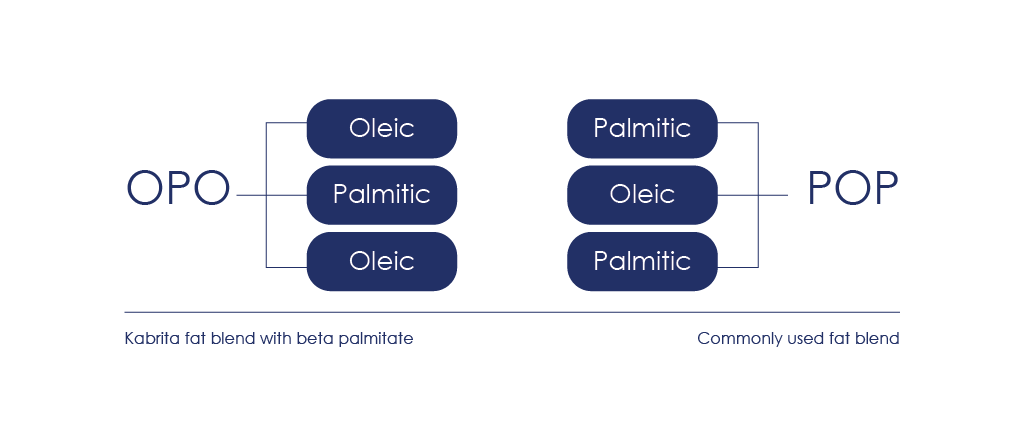Behind the Label: Our Fat Blend with Beta Palmitate

An inside look at fat blends with beta palmitate, and how they increase the absorption of calcium and essential fatty acids while improving digestive health.
What is a fat blend with beta palmitate?
In the US, the infant formula industry standard is to replace animal fat with a vegetable oil blend in order to best match the complex fatty acid composition found in breast milk. Kabrita Goat Milk Formula contains a fat blend with beta palmitate, a premium blend of plant-based oils that is modeled after the fats found in breast milk. While all fat molecules consist of three fatty acids attached to a triglyceride backbone, the fatty acids can be arranged differently.
Commonly used fat blends have fatty acids organized on the backbone in this order: palmitic-oleic-palmitic (POP). In a fat blend with beta palmitate, the fatty acids are arranged: oleic-palmitic-oleic (OPO). While this may seem like a simple change, these are two completely different fat molecules and therefore behave differently in the body.

Why do we add a fat blend with beta palmitate?
Fats are an essential component of formula and are crucial for normal growth and development. They are particularly important for cell membranes, eye, brain, and immune system development. About 20-25% of the fat in human breast milk is palmitic acid, which supports key functions in fat and mineral absorption, and intestinal function, and 70% of this exists in the beta palmitate form.
Fat blends with beta palmitate have been positively associated with:
1. Improved calcium absorption
When palmitic acid is arranged in the first and third positions, as we see in commonly used formula fat blends, the palmitic acid can detach from the triglyceride and form a bond with calcium. The new palmitic acid-calcium group (called a calcium soap) gets excreted from the body – taking the calcium your child needs with it.
with a fat blend with beta palmitate, the palmitic acid stays attached to the backbone and cannot couple with calcium. This means more calcium gets absorbed into the body.
Research has shown children fed formula with beta palmitate absorbed 15% more calcium than children fed formula with a commonly used fat blend. Studies have also shown the effect of formula with beta palmitate on calcium absorption to positively impact bone development.

2. Improved stool consistency
The creation of calcium soaps can lead to harder stools and constipation. As explained above, fat blends with beta palmitate improve calcium absorption because they do not create calcium soaps. One study showed that stool consistency in constipated children was corrected 90% of the time when fed formula with beta palmitate compared to 50% of the time when fed formula with a commonly used fat blend.

3. Gut microflora
Fatty acids also fuel gut microflora (the healthy bacteria that live in the digestive tract). These bacteria are important for children for many reasons: not only are they crucial in promoting healthy digestion, but they also regulate the development of the immune system. One study shows that children fed formula with a fat blend with beta palmitate and breastfed children had higher amounts of microflora compared to that fed formula with a commonly used fat blend.
4. Colic and gas
A fat blend with beta palmitate has also been shown to decrease colic and gas in children. Several studies have reported a positive association between the intake of a fat blend with beta palmitate and behavior. Results have shown that children receiving a formula with a fat blend with beta palmitate had a decrease in crying episodes. In one study, the crying behavior of children fed formula with beta palmitate was comparable to that of the breastfed group.
5. Improves fat absorption
Fats are crucial for normal growth and development, and particularly important for cell membrane, eye, brain, and immune system development. However, the way different fats are structured impacts how they are absorbed by the small intestine.
Studies have shown that palmitic acid is most absorbable when it is in the middle position on the backbone (like we see in an OPO fat blend with beta palmitate): 91% of palmitic acid is absorbed from a fat blend with beta palmitate compared to 79% from a commonly used fat blend.

Improved stool consistency, as well as increased calcium and fat absorption, make a fat blend with beta palmitate such as OPO, an excellent choice.
Behind the label is an ongoing series looking at the ingredients we choose to include in Kabrita products, in order to help parents make nutritional decisions for their family with confidence and joy.
Kabrita Goat Milk Toddler Formula may be an option for little ones during feeding transitions, such as weaning and supplementing, or those with minor issues associated with cow milk sensitivity*.
*Not suitable for children with confirmed cow milk protein allergy